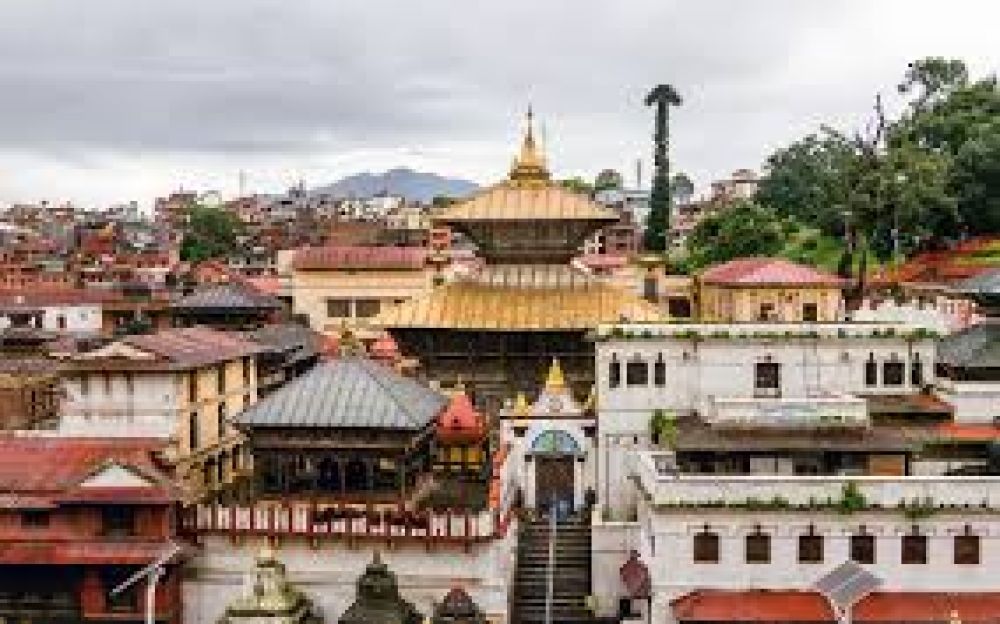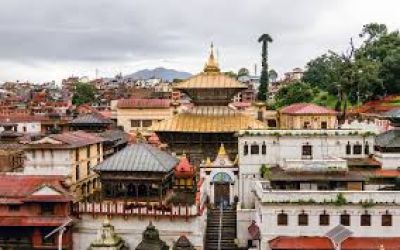

Visitors can experience the spiritual ambiance of the sacred Hindu temple, Pashupatinath, located on the banks of the Bagmati River in Kathmandu, Nepal. Dedicated to Lord Shiva, the temple is a UNESCO World Heritage Site and attracts thousands of pilgrims from around the world. The Darshan, or act of seeing, involves witnessing the revered Shiva Lingam, the divine symbol of Lord Shiva. Pilgrims can also view the richly ornamented pagoda house and the golden spire of the temple. It is not only a religious journey but also a way to admire the exquisite Nepalese temple architecture and the vibrant rituals performed by devoted priests.
Every evening, the Pashupatinath Temple holds an Aarti ceremony on the banks of the Bagmati River, which is a devotional ritual that uses fire as an offering. It's a mesmerizing event where priests perform a synchronized ritual with lamps, incense, and music. The Aarti ceremony at Pashupatinath is a deeply spiritual and visually stunning experience that draws a crowd of worshippers and visitors alike. The air fills with the sound of ringing bells, chanting, and devotional songs. Watching the flames from the oil lamps reflecting on the river waters can be a profoundly moving and magical moment.
Starting the day with the Morning Pooja at Pashupatinath provides a unique insight into the daily rituals and traditions of Hindu worship. Early in the morning, devotees gather to offer prayers and make offerings to Lord Shiva. Attending the Pooja allows visitors to experience the temple at one of the most tranquil and serene times of day. The air is filled with the scent of incense and the sounds of chanting Sanskrit mantras, creating an otherworldly atmosphere. Participating in or observing the pooja is a way to connect with the deep-rooted spirituality and culture of Nepal.
The Pashupatinath Temple is not just a single structure but a sprawling complex of temples, ashrams, images, and inscriptions stretching along the Bagmati River. A guided tour can take you through the various nooks and crannies of this holy site, revealing the history and importance of each location within the complex. You'll see Sadhus (Hindu holy men), meditating by the river, and can observe the funeral pyres that line the ghats, providing a stark reminder of life's impermanence. Visitors often find this experience to be both enlightening and humbling.
Given its deeply spiritual environment, Pashupatinath Temple is an ideal place for meditation and yoga. There are often sessions conducted by experienced practitioners who guide participants through various techniques aimed at enhancing physical, mental, and spiritual well-being. Imagine performing yoga asanas or meditating in the serene ambiance of this ancient temple, surrounded by the natural beauty of the area. It's an activity that can provide peace and balance to travelers amidst their journey.
For history buffs and culture enthusiasts, exploring the area around Pashupatinath Temple offers a deep dive into the local customs and historical significance of Kathmandu. A cultural and historical walk typically includes visits to the many smaller temples and heritage sites within the complex, with detailed explanations provided by a knowledgeable guide. You can learn about the architectural styles, the significance of the temple to the local populace, and the various festivals and events that take place throughout the year. This walk is an excellent way to not only see the temple but to understand its place in the heart of Nepali culture.
Photography enthusiasts will find the Pashupatinath Temple complex a treasure trove of opportunities for capturing stunning images. With intricate carvings, stone sculptures, and the beautiful setting on the riverbank, there are endless subjects to photograph. However, it's essential to be respectful and aware of the rules around photography at this sacred site, especially concerning funeral rites. There are also local photographers who can lead tours and provide insights into the best spots and times of day to capture the beauty of Pashupatinath.
The Maha Shivaratri festival, dedicated to Lord Shiva, is one of the most significant and celebrated events at Pashupatinath Temple. During this festival, thousands of devotees from Nepal and India flock to the temple to partake in the festivities, which include lighting oil lamps, singing hymns, and making offerings. This is a unique opportunity to witness Hindu rituals at their most fervent and to participate in a night-long vigil that marks Shiva's marriage to Parvati. The festival atmosphere during Shivaratri is full of devotion, color, and vibrancy, offering a truly once-in-a-lifetime experience for those in attendance.
In and around the Pashupatinath Temple complex, various Sadhus or Babas, who have renounced worldly life for spiritual practice, offer blessings to visitors. For many, receiving a blessing from a Baba, who is considered to embody aspects of Shiva due to their ascetic lifestyle, can be a unique and auspicious experience. Many of these Babas are friendly to visitors and are often willing to discuss their way of life with those who are genuinely interested, providing a fascinating glimpse into a life dedicated solely to spiritual pursuits.
Interested visitors can take the opportunity to learn about the various rituals performed at Pashupatinath Temple. This can include learning how to conduct a Puja ceremony, understanding the symbolism of offerings, and the meanings behind the sacred chants and mantras. Such an experience provides a closer look at Hinduism's practices and can be a deeply enriching activity. It's important to approach this with the utmost respect, as these traditions are ancient and central to the beliefs of the worshippers who visit the temple.
